Bead weaving is slightly different than weaving with yarn. First, the loom is not like the ones we use for fabric. The bead loom has a stable warp, usually made of nylon filament. No movement is needed to interlace the beads with the warp. Instead, the beads are lined up on a needle for the row being woven, the needle with the beads is placed under the warp and the beads are pressed through the warp in the correct places. The needle, threaded with the weft filament, is then pulled through the beads. The needle and weft thread then comes back over the top of the warp and through the bead eyes, locking the beads in place.
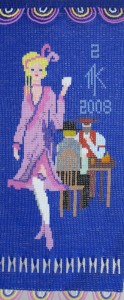
Dance Hall Girl
This seemingly simple technique captivated Monte Klein when she was introduced to it. She had signed up for a workshop in bead weaving given by Linda Cannefax through the Tamalpais Guild about 12 years ago. The class project was weaving a simple band as a way of learning the technique. Monte’s imagination went wild! She could imagine all sorts of ways to use what she had learned.
The class was weaving garters as part of getting ready for a Goldrush themed Conference.
Monte wove the dance hall girls.
Of course, by doing so, she ran into some challenges of this ‘simple technique’ as the looms tend to be narrow. The dance hall girls needed to be wider than the loom. Monte did them in two strips and sewed them together!
This led to Monte designing looms that were wider and having them built for her. She has designed several looms and found ways to overcome several new challenges such as tension, controlling long warps and stabilizing the sett.

Mayan Maiden
In the meantime, her beadweaving projects have gotten more intricate and bigger.
To display these pieces properly, Monte designs stands for them. They are reversible and are meant to be displayed where they can be admired from both sides and light can shine through them.
The pieces also call out to be touched and admirers are always surprised at how heavy they are! Monte encourages the touching, seeing it as a meditative experience
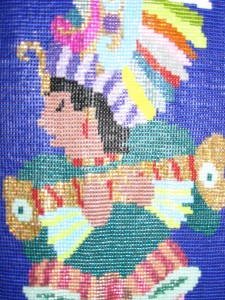
closeup
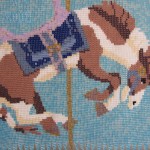
Carousel Series
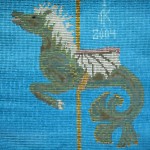
Carousel Series
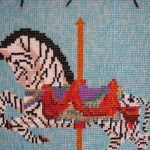
Carousel Series
Monte’s projects have been inspired by photographs, cartoons, coffee table books, suggestions from her family, and calendar pictures. She does her own drawings and then, using a light box, transfers the picture on to a special graph paper that is made to mimic the rectangular footprint of the beads. After that, she transfers the design to a larger sized graph paper in order to be able to see the design better as she works.
Remember your first weaving experience? Relive it reading about frame looms.